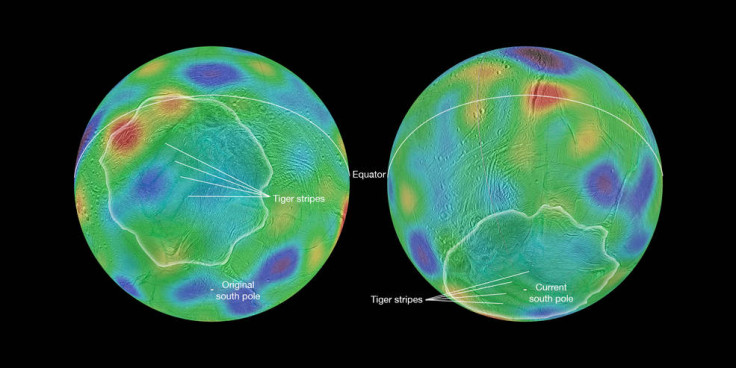Cassini images suggest asteroid strike forced Enceladus poles to shift
Saturn's icy moon's spin axis has reoriented from its original position.

Nasa has announced that asteroid strikes may have tipped over Saturn's icy, ocean-bearing moon Enceladus. Researchers came to the conclusion after analysing the latest images and data from Cassini.
Researchers say they have enough evidence to suggest the moon's spin axis – the line through the north and south poles – reoriented from its original position due to a collision with a smaller body, most likely an asteroid. The shift from its original axis is by 55 degrees, more than halfway rolling completely onto its side.
"We found a chain of low areas, or basins, that trace a belt across the moon's surface that we believe are the fossil remnants of an earlier, previous equator and poles," said Radwan Tajeddine, a Cassini imaging team associate at Cornell University, which collaborated with Nasa on the research.
The current south pole on the Enceladus has been established as a geologically active region where long, linear fractures referred to as tiger stripes are spread across the surface. The fractures in the region show that it was originally closer to the equator according to the space agency.
Tajeddine explains why the shift was not a result of internal geological activity but external force saying, "The geological activity in this terrain is unlikely to have been initiated by internal processes. We think that, in order to drive such a large reorientation of the moon, it's possible that an impact was behind the formation of this anomalous terrain."
Back in 2005, Cassini had found jets of water vapour and ice particles in the tiger stripe fractures.
The vapour and icy particles spraying from the tiger stripe fractures suggests that an underground ocean exists, which contains hydrogen gas. According to researchers, the gas could potentially provide a chemical energy source for life, suggesting the oceanic conditions on the moon are habitable for certain microbes.
The Cassini, a cooperative project of NASA, ESA (European Space Agency) and the Italian Space Agency is set to retire this September as it plunges into Saturn's inner rings.
© Copyright IBTimes 2025. All rights reserved.




















